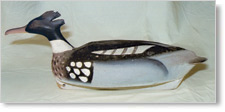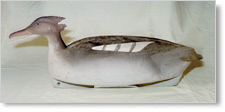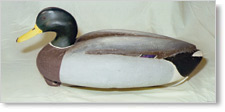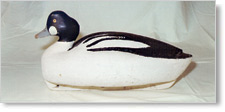by Richard Cowan and Richard LaFountain
Leonard Tucker was born in 1901, the second son of John Tucker and Bertine Gimlett. He was one of eight children, five girls and three boys. One of the boys, Forrest, died in infancy, but Len and his brother, John, followed the bay as had generations of Tuckers before them.
The two Tucker boys worked on the bay, and following the seasonal changes clammed, gill netted, eeled, scalloped or hunted, according to the cycles of the seafood and game markets and the natural world. They would set eel pots and larger fish pots to catch the seasonal runs of fish. An English caller and several geese and brant were kept as tollers to attract waterfowl that were shot for the New York City markets when game could still be sold. Black duck and broadbill were also shipped to market. Len captured the live birds by setting muskrat traps wrapped with burlap and baiting the area with corn.
| |

 |
| |
Len Tucker red-breasted merganser pair.
|
Len especially enjoyed hunting waterfowl and carved a rig of hollow stool in the early 1930s. over time he added to the rig until it numbered about 250 brant, broadbill, geese, black ducks, whistlers and a few canvasbacks. According to his former gunning partner, Charlie Peppard, in 1952 Tucker’s rig boasted 252 assorted decoys. The few cork birds from this period were made with a 3/4-inch bottom board. Len and his partner, Oliver Locker, hunted from a battery rig for several years before switching to two layout boats that could be grassed to hunt for black ducks.
Tucker carved most of his decoys after World War II and, curiously, made no more hollow decoys. Just as unusual, the post WW II models were largely made of white cork and many had root heads, a material and method that had gone out of style before the war. Although his production consisted largely of cork broadbills and black ducks, he made quite a few other cork stools in a variety of species as well as numerous decoratives. Nearly eighty percent of his entire output was sold to local gunners and collectors.
During WW II Tucker served in the U.S. Coast Guard along with many other baymen and fishermen. Most of his service time was aboard a fireboat based in New York harbor. He passed many of his waiting hours whittling small ducks, geese and mammals. During this time he became an accomplished miniaturist. His flying waterfowl are noteworthy for their deeply cupped wings, detailed paint and the resultant realism. The standing birds are all carved from a single piece of wood. He began the carving by drawing a profile of the side of a black of wood. Next he drove a small nail into the bottom, positioned within the feet and legs. As he carved the legs and feet, he left the wood between the legs containing the nail as additional support to prevent breakage.
Shortly after his military service ended, Tucker developed asthma. He frequently found himself out of breath and soon realized he could not continue his rigorous life on the bay. Increasingly he worked ashore. His doctor recommended a move to a more salubrious climate, such as that in Arizona, but Len did not want to leave his West Sayville roots. He began to spend more time carving and whittling, a time that proved to be the most productive carving period of his life.
 |
|
Len Tucker mallard.
|
|
Tucker was unable to cut the pine trees necessary to make heads, so a young neighbor who wanted some decoys for hunting went to the pine barrens to do it for him. As late as the 1960s local baymen and boys scoured old boathouses to find abandoned life jackets for him. These canvas-covered relics were made of the natural, or white, cork he preferred to make his decoys. Using a rasp instead of a drawknife was easier for Len and most of his later birds are made of this lightweight but strong material. The cork had to be carefully rasped to create flat and square edges that could be carved with a rasp. Except for the geese and brant stool that he made with root, or more properly, branch heads, his decoy heads are carved of white pine. In the 1950s he made a few decoys from Styrofoam, but did not particularly like the material and made no more. His decoys are typically full-bodied and exhibit a slightly tucked head that imparts a life-likeness that is very appealing - on the water or on a display shelf.
Tucker painted the bodies of all his cork decoys, including the black ducks. Many Long Island makers would torch the cork bodies for black duck decoys. He liked to fill the voids in the cork with sawdust to produce a more even painting surface. Early on he used asphaltum paint as a binder, but later switched to Wellwood glue. The surface was not sanded smooth and did not shine after painting. His birds are carefully painted, although many hunters feel his black duck heads are too yellow. His earliest black duck heads have a pattern of dots applied with a blunt stick over a yellow ochre base. Later ones have the same base color, but the dots were replaced by delicate brush strokes.
| |
 |
| |
Len Tucker goldeneye.
|
At the height of his career, Tucker made full size decoratives as well as miniatures. He often gave these as gifts to friends and to date few have come to auction. He made quite a few carefully painted full-bodied cork birds for collectors and friends as well as beautifully carved pine decoys. A good number of the pine birds were mounted on lamps, and these are among his best work. The bills on the decorative decoys were often painted with clear nail polish to achieve a glossy finish. Except for a few early pieces, all of Tucker’s decoys and decoratives were made with glass eyes. The sizes of the decorative carvings varied according to the block of wood available, however the gunning decoys were more uniform, with only an occasional oversized bird found.
Len, who passed away in 1975, carved an estimated 800 to 1000 decoys, decoratives and miniatures in his lifetime. The majority of his work is still in the possession of the original owners or their children. With the passing of these generations, Len Tucker’s decoys are bound to become more widely available in the decoy market.
For the complete story, please see the Jan./Feb. 2003 issue of Decoy Magazine.
Tidbits Main Index

|


